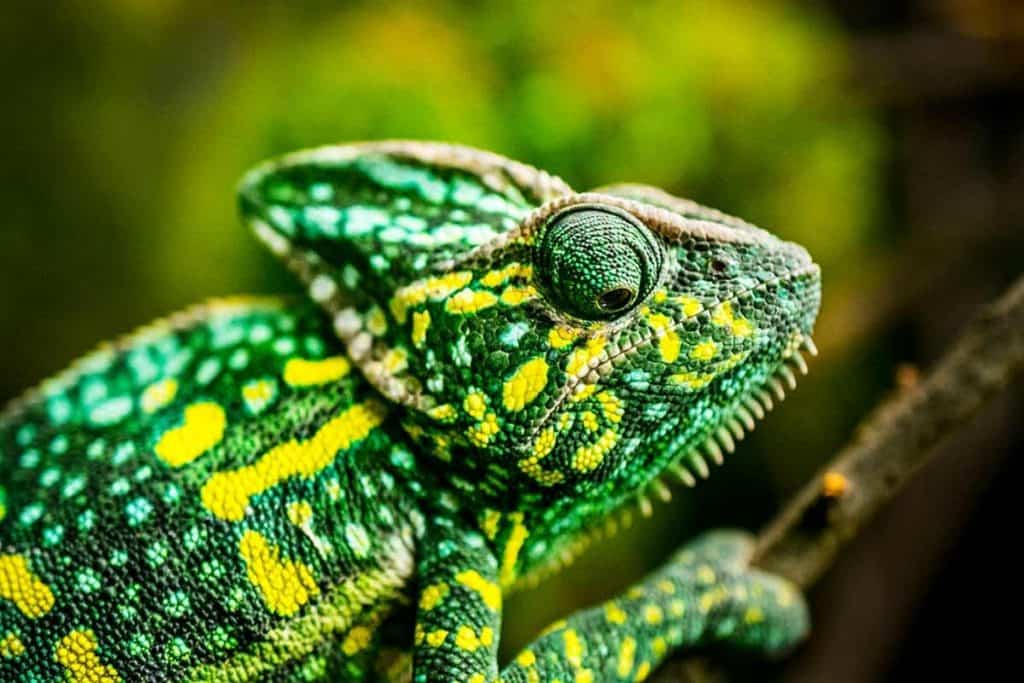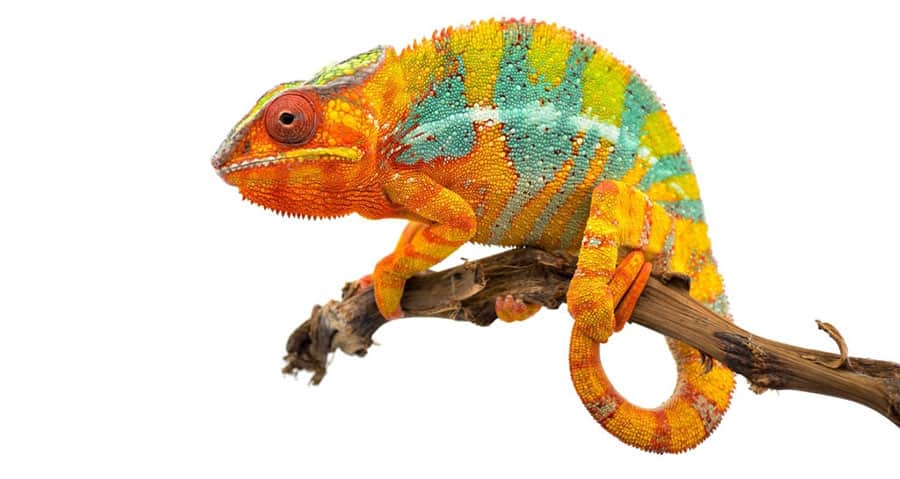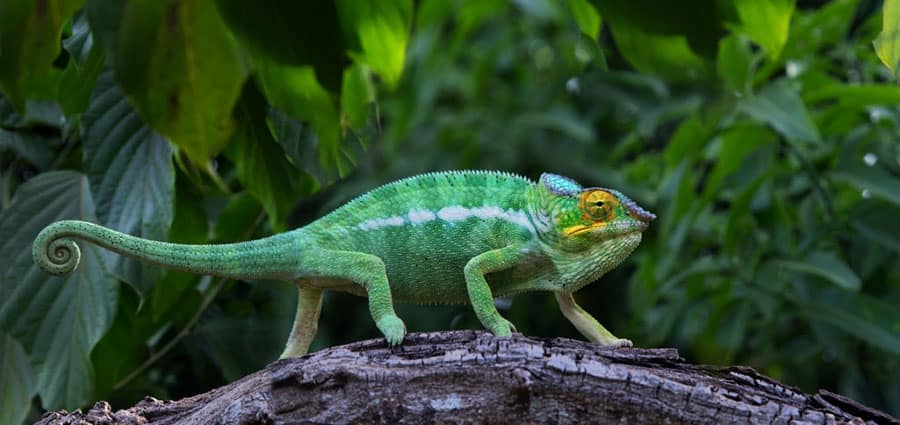
Owning a chameleon is not a cheap hobby. This is a pretty well-known fact in the pet and reptile industry.
How Much Are Chameleons? On average, chameleon pets can range anywhere from $30 to $300. Common species like Veiled Chameleons or Panther Chameleons are typically more affordable, while rarer species or morphs with unique color patterns may command a higher price.
The chameleon itself is not too expensive if you are looking for a common species like the veiled or Jackson’s chameleon. However, if you are looking for rarer species like the Parson’s chameleon, then you could end up spending a lot more.
The main cost when it comes to owning a chameleon comes from their upkeep. Their enclosure needs to be bought, properly set up, and maintained. Their food needs to be bought regularly, and if you breed the live feeder insects yourself, then you’ll also need to maintain their enclosures and upkeep costs, too.
Finally, a chameleon’s vet bills can be quite pricey because they are unforgiving lizards. Additionally, just any vet won’t do; chameleons need a vet that specializes in reptiles and other exotic animals.
While all of this can seem daunting at first, you need to know what you are getting into when you want to buy a chameleon. Being prepared means you can cater to the chameleon’s every need so it can live a long and healthy life.
How Much Are Chameleons?
| Chameleon Species | Cost Range (USD) |
|---|---|
| Veiled Chameleon | $50 – $150 |
| Panther Chameleon | $150 – $400 |
| Jackson’s Chameleon | $50 – $150 |
| Carpet Chameleon | $80 – $200 |
| Flap-necked Chameleon | $50 – $150 |
| Oustalet’s Chameleon | $200 – $500 |
| Fischer’s Chameleon | $100 – $300 |
| Senegal Chameleon | $25 – $60 |
| Translucent Veiled Chameleon | $100 – $250 |
| Nosy Be Panther Chameleon | $200 – $500 |
Chameleons cost different amounts depending on their species, age, sex, and morph or type of coloration. The following species below are commonly kept as pets.
Senegal Chameleons
Senegal chameleons are not easy to care for. However, they tend to be cheaper than other chameleons with simpler care needs, which can work against new owners who want cheap lizards. The Senegal chameleon can cost, on average, between $25 and $60.
How much is a veiled chameleon?
Veiled chameleons are pretty common in the pet trade because they are the easiest to care for. This also means there are a lot of people breeding them, so they are relatively cheap. You could spend between $50 to $150 on one.
How much does a jackson chameleon cost?
Jackson’s chameleons are also relatively common as pets because their unique appearance keeps them in high demand. This three-horned enigma can cost between $50 and $150 depending on their coloration and age.
Panther Chameleons
Panther chameleons are the most striking chameleons in appearance, and that fact boosts their prices a bit more than the other common pet chameleons. This vibrant, multi-colored lizard can cost anywhere between $150 and $400.
Parson’s Chameleons
Parson’s chameleons are the largest species of chameleons. They are not bred in captivity as much as the aforementioned breeds, which drives up their price. You can expect to pay anywhere from $300 to $1,000 for one depending on its coloration, size, and age!
Other Factors Affecting How Much a Chameleon Costs
Age
Juvenile and subadult chameleons tend to be more expensive than babies. This is because breeders can prove that they are healthy and growing according to their respective species charts.
Hatchling chameleons are very fragile and are often cheaper because there is a higher chance of them dying without expert care.
Adult chameleons are also cheaper than their juvenile or subadult counterparts because they have already lived part of their lives.
Sex
Male chameleons typically live longer than females. This means they are valued more and, as a result, will cost you more. Males are also bigger and have brighter and more eye-catching coloration.
Check out our guide on how long chameleons live. Females live shorter lives than males because they devote a lot of energy and nutrition to developing eggs rather than maintaining their bodies.
However, if a breeder has a female from a clutch of eggs that have been bred for a specific coloration or pattern, then that female could be more expensive than the males in the same clutch.
This is because she will go on to lay eggs for the new owner (if they are interested in breeding her) that could pass on those desired genetic traits. This, in turn, would make her offspring more valuable, and the cycle continues.

Morph/Coloration
Just like any other species of pet, many specific species of chameleons are bred to have brilliant and unique colorations. For example, the veiled chameleon has a translucent morph. Their skin is a ghostly blue color that appears almost see-through!
Breeding desirable traits takes a long time because the traits have to be passed on and mixed through many generations of chameleons. The process of breeding chameleons is very expensive as it is; add on breeding successive generations, and you will end up with pricey morphs.
How Much Does it Cost to Own a Chameleon?
The real cost of owning a chameleon makes itself known when you tally up the price of all of the equipment, setup, and how much it costs to feed the chameleon over its lifetime.
Chameleons require lots of upkeep and have very specific care needs as far as their enclosure setup, diet, and potential health issues. Here are seven major factors you’ll need to keep in mind when it comes to the cost of caring for a chameleon in the long term.
Enclosure
A chameleon cannot be housed in a glass
Chameleons fare best when housed in a screened enclosure or a wooden enclosure that has a screen door. The enclosure will need plenty of vertical and horizontal space for the chameleon to explore and hide, as they are very shy and reserved animals. If the enclosure is too small, then your chameleon will become stressed as it grows.
The problem with a wooden enclosure is that chameleons need high humidity and a constant supply of water droplets. This can cause wood to rot quickly, so the enclosure will need to be replaced more often and require more maintenance.
The average size for a chameleon enclosure is roughly 24” wide, 24” deep, and 48” high. When in doubt, or have the space, always go bigger!
An appropriately sized screen enclosure can cost anywhere from $100 to $200, depending on whether you purchase one pre-made or build one yourself.
Also, you may need to replace the enclosure if it gets damaged or breaks during the chameleon’s lifetime.

Plants
Another important factor when it comes to caring for a chameleon is creating an enclosure that feels like home. Remember, since they are easily stressed, they need plenty of plant cover to feel comfortable. Here are some to consider as well as their average costs.
Live Plants
Your chameleon’s enclosure should be filled with plants, vines, and perches for your chameleon to explore, hide in, and move around on.
It’s best to go the natural route and choose to use real plants in the enclosure. This will help maintain humidity levels and boost the airflow in the enclosure. Speak to a local breeder or pet shop about where you can source plants locally to keep costs down.
Air plants, for example, are a nice addition to your chameleon’s enclosure because they can be attached straight to the screen walls! Air plants are usually sold in bunches or collections and on average can cost around $15.
Make sure the air plants you get are safe for your chameleon in case they feel like nibbling on them. Also, check on their humidity requirements, because your chameleon needs a humid environment, and not all air plants can sustain this.
Fake Plants
You can also use fake plants to make your chameleon’s environment exciting and colorful. These will need to be replaced every couple of years as they will wear down over time.
Hanging plants can be used in the background and should always be anchored carefully. Fern-style hanging plants will give your chameleon maximum coverage for when it’s feeling nervous.
Fake plants can cost anywhere from $5 to $30 depending on quantity, size, durability, and quality of construction.
Perches
Your chameleon should also have a couple of branches in their enclosure in addition to leaves and vines. Fake branches are a perfectly acceptable choice and cost around $15 on average. However, there is also a free option!
You can grab a branch from your garden and boil it in water and some vinegar to kill any organisms living in or on it. Dry the branch in direct sunlight or the oven until it is completely dry. Then securely attach it to the enclosure!
The enclosure and decorations, in total, can cost anywhere from $50 to $300 or even more, depending on what you already have, what you can get second-hand, and if you opt for any DIY methods.
Lighting
Lighting is an expensive part of keeping a chameleon. Yearly, you can expect to pay at least around $200 on the electricity the enclosure’s lighting elements will take up. You will also need to replace UVB and heat bulbs fairly often when they burn out.
Chameleons need lighting to maintain their photocycle as well as for heat. UVA, LED, or halogen bulbs used for light can be cheap if you find deals or bulk options. They can cost anywhere from $10 to $40 per bulb. The cost of bulbs alone averages out at $100 per year.
You should connect the bulbs to an automatic timer to avoid any mishaps. This is an extra cost, which is on average $10, but it will save you money in the long term if you are prone to forgetting to turn the enclosure lights on and off at a specific time.
Heating
Many heating sources for reptile enclosures are combination heating and lighting sources. This might seem like it would save money; however, these bulbs are more expensive to replace because they perform two functions. Be careful when you purchase them and compare different options to find the best bulb to suit your chameleon’s enclosure size and setup.
Heating bulbs need to be replaced fairly often, or every couple of months on average. A heat source like a basking bulb to maintain the appropriate temperature within the enclosure is crucial to your chameleon’s health.
On average, replacement heating bulbs can cost anywhere from $10 to $20 each.
Humidity and Hydration
Chameleons need carefully controlled humidity levels. The humidity in their enclosure cannot drop below 65% and should not go above 80%. If the humidity drops below the appropriate range, your chameleon will become dehydrated. Alternatively, if it goes above that range, your chameleon will develop a respiratory infection.

Misting/fogging systems will help maintain the humidity levels in your chameleon’s enclosure. They will also provide a constant supply of condensed water droplets for your chameleon to drink from. However, they can be pricey and cost around $50 on average.
They also require constant electricity to run, which will add up to another couple hundred dollars a year.
However, there is a cheaper way to maintain humidity! Just do it by hand. Use a pump-action misting bottle to mist the enclosure twice a day. This can cost around $10. This will be enough to maintain humidity, but it will not be enough to provide enough water from your chameleon to drink.
To provide enough water for your chameleon to drink and stay hydrated, you’ll need a dripping system. A dripping system costs between $10 and $30 depending on the size and brand. You can also make one yourself and save some money!
Remember that water is not free, and your chameleon will need fresh water every day. The water in the misting system, dripping system, or handheld bottle needs to be changed daily.
Food
Food is a big cost when it comes to owning any kind of pet whether it is squishy, feathery, or scaly.
250 live crickets will last you roughly 10 to 20 days. This quantity of crickets costs around $3 to $10 depending on where you purchase them. If you were to only feed your chameleon crickets, you would spend around $100 a year on their food.
However, chameleons need more than just crickets to eat. Variety in your chameleon’s diet is key. For 25 hornworms, for example, you will pay around $15, and this will feed your chameleon for around 15 to 20 days.
A more cost-effective method of feeding your chameleon would be to raise your own live feeders and buy the treat items from online distributors, local breeders, or pet shops. This, of course, will come with its own costs.
Do not forget the supplements! Your chameleon needs a
Vet Visits
Chameleons get sick easily, which means you’ll be making frequent vet visits. Additionally, a normal mammal-focused vet is not going to be enough for your chameleon. You’ll need to find a vet that specializes in exotic pets like reptiles or, even better, chameleons specifically!
A typical vet visit with diagnostic testing and medications can cost anywhere from $150 to $500! So, be aware that you’ll need to set some money aside or invest in pet insurance for your chameleon.
FAQs Chameleon Costs
Can I keep a chameleon on a budget?
Chameleons are very expensive and cannot be housed on a budget without their health being negatively impacted. There’s no way around this; they have very specific care needs.
Other lizards that are more budget-friendly include geckos and skinks. Check out our guide on the best beginner lizards to see if one of them better suits you and your budget!
Chamillionaire Checking Out…
How much does a chameleon cost to buy and keep? In short, it costs a lot. However, it is definitely worth it to own one of these unique and fascinating animals!
Chameleons require constant, specific care and can become quite expensive to care for compared to other common pet reptiles. However, there are plenty of ways you can cut costs by being resourceful and following the tips outlined in this guide!





